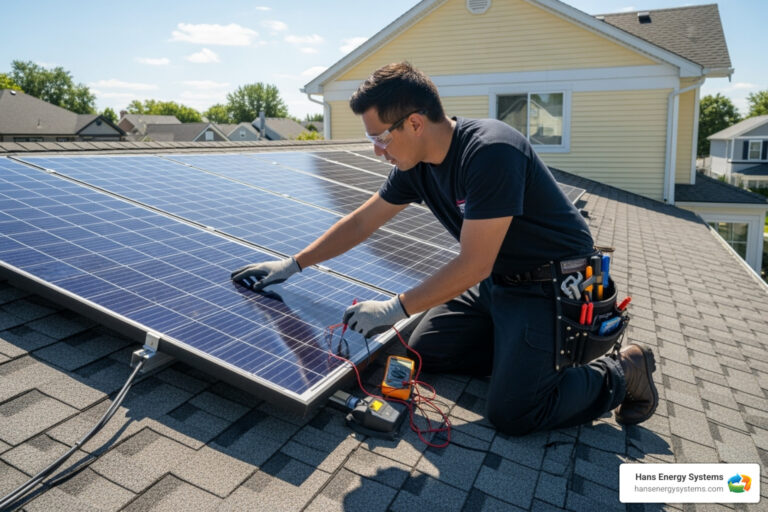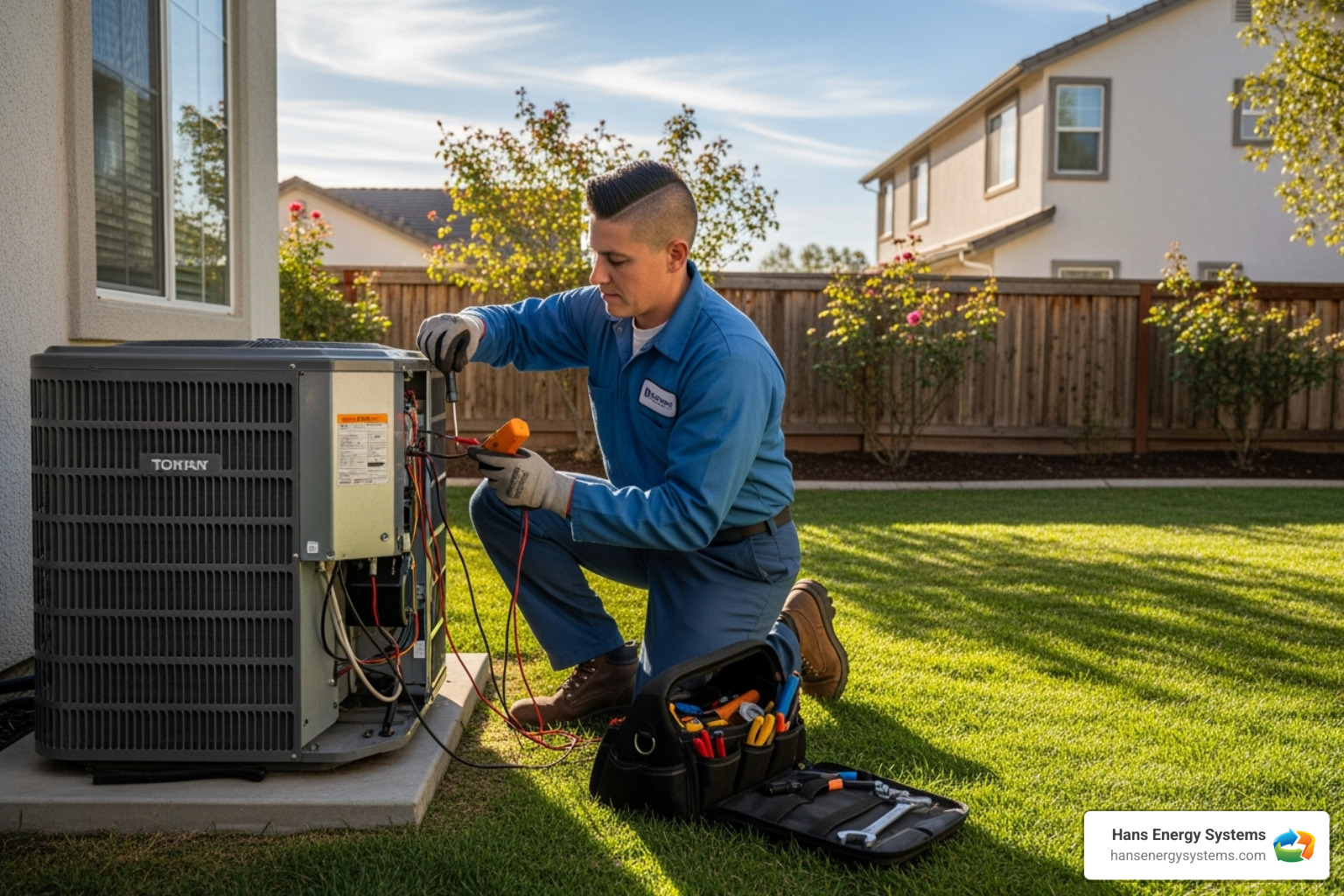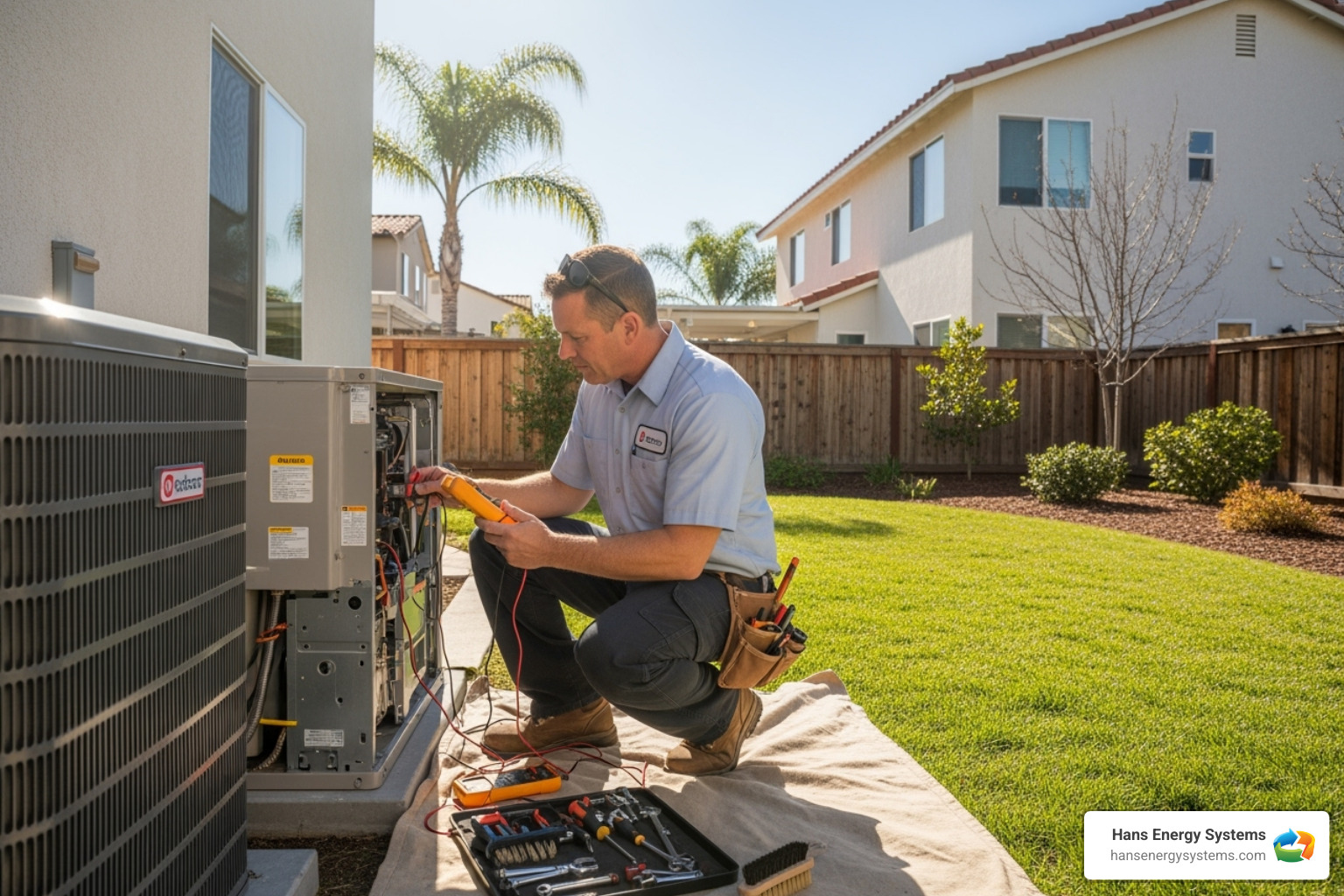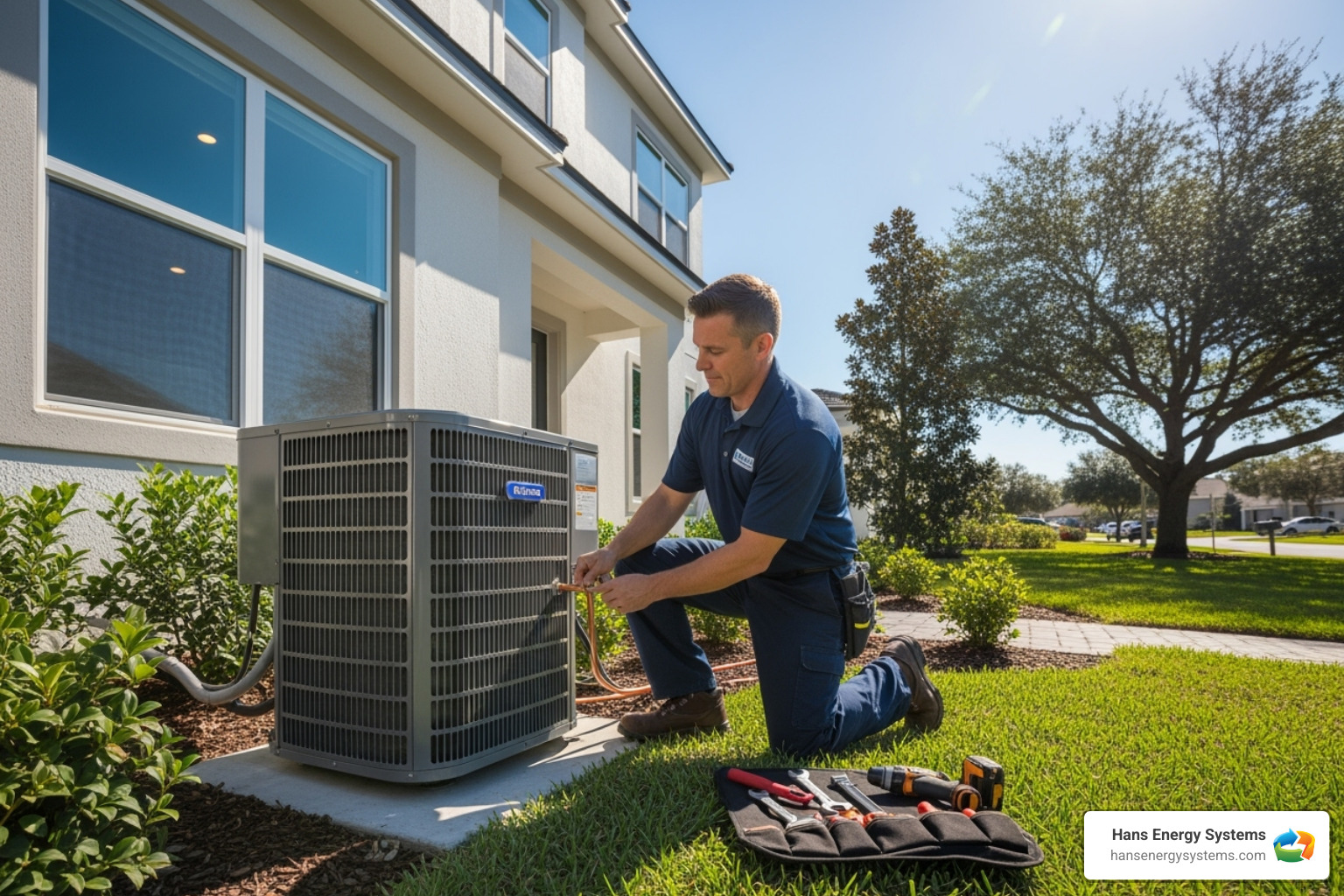Why Solar Panel Upkeep is Crucial
Solar panel repair is critical for saving money and maintaining optimal energy production. With over 3 million US homes using solar power, which supplies 3.9% of the nation’s energy, addressing common issues is key to protecting your investment.
Most common solar panel repairs include:
- Microcracks – Hairline fractures from thermal cycling
- Inverter malfunctions – Converting DC to AC power failures
- Loose wiring – Connections weakened by weather or pests
- Broken glass – Impact damage from hail or debris
- Performance degradation – Gradual efficiency loss over time
Solar panels are built to last 25-30 years but face constant challenges from weather, debris, and normal wear. Even minor damage can significantly impact performance—dirty panels alone can reduce energy output by up to 30%.
The good news is many repairs are manageable. Simple maintenance like cleaning can often restore efficiency without professional help. However, major electrical work requires expert intervention to protect both your safety and your warranty coverage.

Identifying the Problem: Signs Your Solar System Needs Attention
Learning to recognize your solar system’s subtle signals can prevent small issues from turning into expensive headaches. Let’s walk through the most common signs your system might need help.
Common Types of Solar Panel Damage
Your solar panels are constantly battling the elements. Here’s what to watch for:
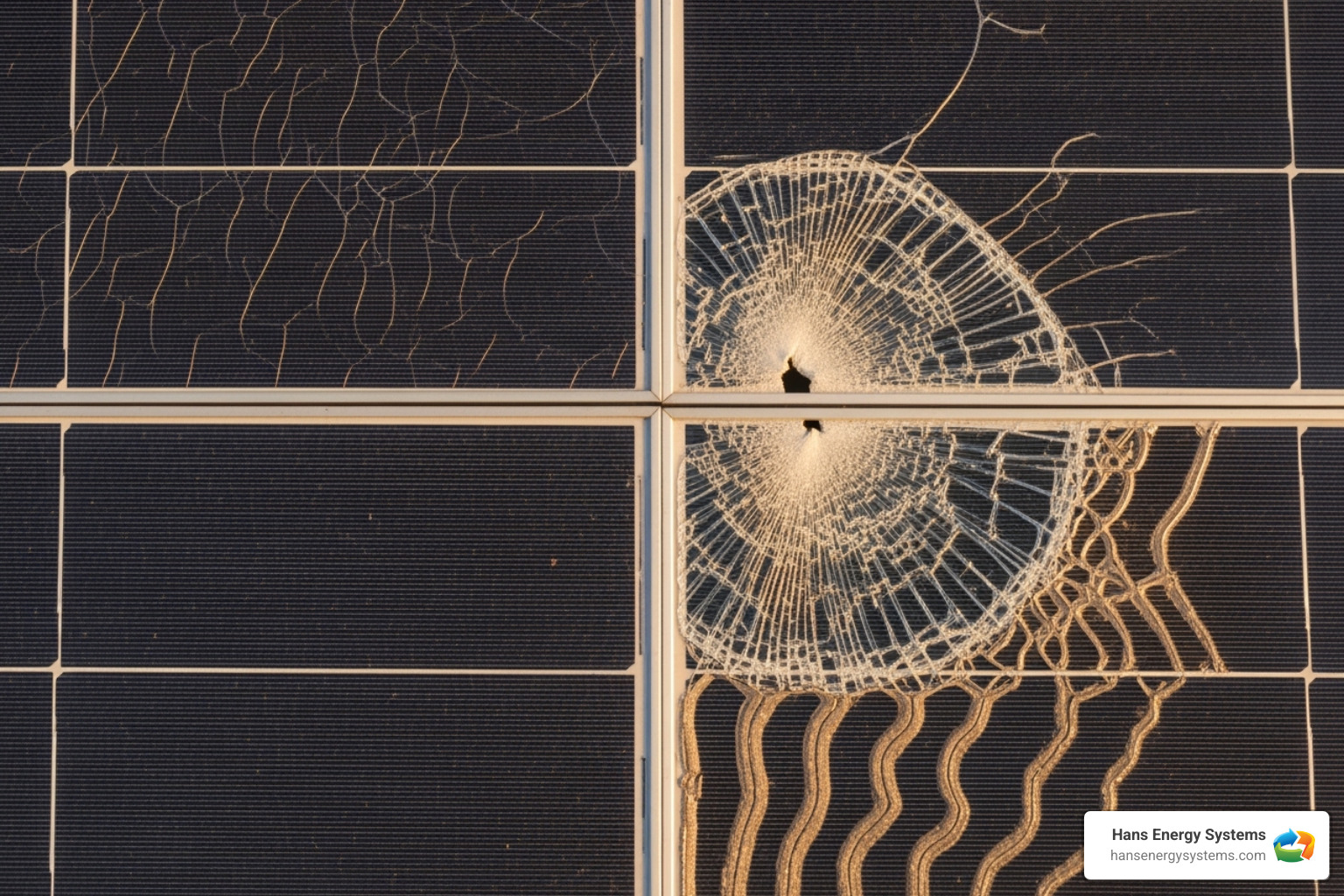
Microcracks are hairline fractures, often invisible, that can seriously impact performance. Solar cells are vulnerable to thermal cycling, where temperature changes cause expansion and contraction. These cracks can lead to hot spots and snail trails (discolored streaks), indicating internal damage.
Broken glass is an obvious problem that allows moisture inside, which can cause serious electrical issues and safety hazards.
Delamination is when a panel’s protective layers peel apart, usually due to moisture or manufacturing defects. You can learn more about this at Delamination.
Weather is a major factor in solar panel repair needs. Even in sunny San Diego, storms can cause damage. Debris accumulation from dust, leaves, or bird droppings can reduce energy production by up to 30%. For more details, see how weather affects solar panel performance.
Electrical and Component Failures
Sometimes the problem lies with the electrical components.
Your inverter converts DC power from panels into AC power for your home. Signs of failure include decreased energy production, flickering power, or inverter error codes. Loud or strange noises also signal trouble.
Faulty wiring and loose connections are serious issues that can cause power drops, visible wire wear, or burning smells. They are often caused by weather or pests.
Circuit breaker issues, like frequent tripping, are a clear sign that your system has a problem.
Junction box defects on the back of panels can cause short circuits if moisture gets inside. Quality boxes should have an IP67 rating for protection.
If you’re interested in adding resilience, learn about battery backup systems for solar panels in Poway.
Wear, Degradation, and Mechanical Damage
Even the toughest panels age over time.
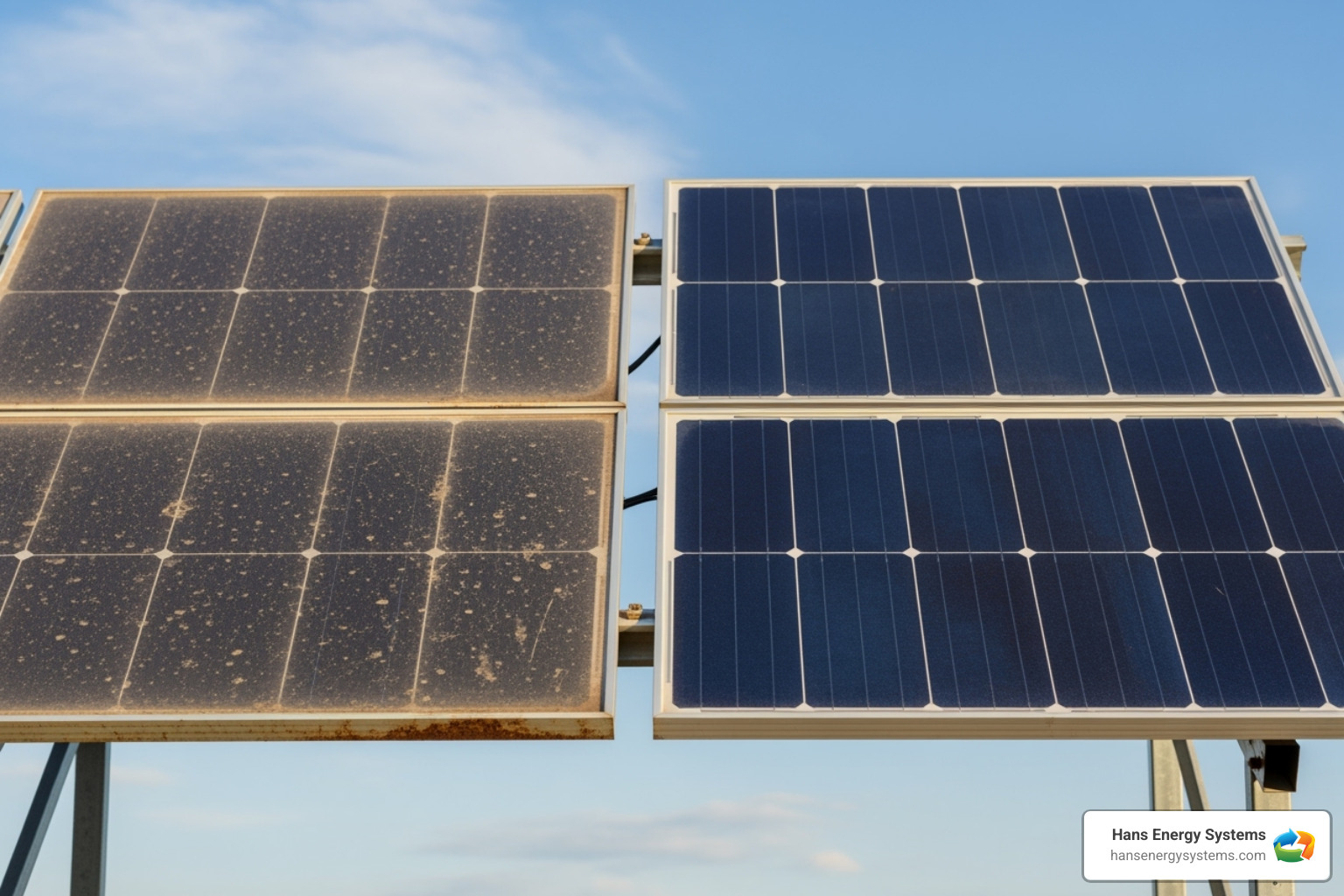
Gradual performance loss is normal, with most panels degrading at a rate of 0.5% to 1% per year. However, a faster decline, discoloration (yellowing or browning), or corrosion on the frames warrants a closer look.
Warping or bending can result from extreme temperatures or physical stress.
Pest damage is surprisingly common. Rodents chew on wiring, and birds build nests under panels, both of which can cause serious performance and safety issues.
Shading from new trees or construction can also significantly reduce your output. Learn more about how shade affects your solar panel output.
Most of these problems are manageable when caught early through regular inspections and maintenance.
A Step-by-Step Guide to Solar Panel Repair
While not every solar panel repair requires a professional, you must approach any work with respect for safety and your system’s complexity. This guide will help you get your panels back to peak performance.
Step 1: Safety First – Shut Down Your System
Working with live solar components is extremely dangerous. Always shut down your system completely before any inspection or repair. This step is non-negotiable.
First, turn the DC disconnect switch (usually a red-handled switch near your inverter) to “OFF.” Next, turn off the inverter power switch. Finally, head to your home’s main electrical panel and switch the circuit breaker labeled for your solar system to “OFF.”
Always consult your manufacturer instructions for specific shutdown procedures. Your safety is paramount.
Step 2: Gather Your Tools and Safety Gear
Having the right tools and safety gear is essential. You’ll need a multimeter for electrical tests, wrenches, screwdrivers, and a soft brush with non-abrasive cleaner and deionized water. For safety, use insulated gloves, safety glasses, and if you’re going on the roof, a proper harness and slip-resistant footwear.
Step 3: Conduct a Thorough Visual Inspection
Start your investigation from the safety of the ground.

Use binoculars to look for major cracks, significant debris, or signs of pests. If it’s safe to access the roof, perform a closer inspection. Check for cracks in the glass, look for discoloration that could signal hot spots, inspect wiring for fraying or chew marks, ensure all mounting hardware is tight, and note any debris or pest nests that need clearing.
Step 4: Clean the Panels and Clear Debris
Cleaning panels can often restore a surprising amount of lost efficiency. Use a soft brush and gentle, non-abrasive cleaner, then rinse with deionized water to prevent mineral deposits. Avoiding pressure washers is crucial, as their high-pressure streams can damage panels and break seals.
Clean during cooler parts of the day, like early morning or evening, to avoid thermal shock from hitting hot panels with cool water. Gently remove leaves and nests, and consider installing pest guards if activity is a recurring problem.
For more detailed cleaning strategies, check out our guide on solar panel cleaning and maintenance.
Step 5: Check and Tighten Connections
Loose connections reduce efficiency and create safety hazards. Carefully inspect wiring connections for anything that appears loose, corroded, or burnt. Gently tighten accessible connections with your insulated tools, but do not overtighten. Also, check junction box seals to ensure they are intact and keeping moisture out. If you find any signs of burning, exposed wires, or heavy corrosion, stop immediately and call a professional.
Step 6: Test Panel and System Output
With the system still safely shut down, you can use a multimeter to measure the DC voltage of individual panels or strings. Checking voltage and comparing panel outputs helps identify underperforming units. After restarting the system, monitoring the inverter display for performance data is crucial. Track daily energy production and compare it to historical data, accounting for weather.
Step 7: System Reboot and Final Check
Time to bring your system back online. Safely restart the system by reversing the shutdown procedure: turn the AC breaker to “ON,” then the inverter power switch to “ON,” and finally, the DC disconnect switch to “ON.”
Monitor performance for 24-48 hours using your monitoring app or inverter display. Document your findings and compare performance to previous days. If performance is still lagging or you encountered issues beyond your comfort zone, it’s time to call for professional help.
DIY vs. Professional Repair: Knowing Your Limits
When it comes to solar panel repair, knowing when to DIY versus calling in the experts is critical for safety and avoiding costly disasters.
When DIY Is an Option
Some maintenance tasks are safe for DIY, provided they don’t involve electrical work or significant roof safety risks.
- Minor cleaning of dust, pollen, and bird droppings can significantly boost performance.
- Tightening loose bolts on mounting hardware (not electrical connections) is manageable if you have safe access.
- Clearing debris like leaves and small branches is another simple DIY task.
While some attempt to seal tiny microcracks with UV-resistant resin, this is a risky temporary fix that can void your manufacturer’s warranty. We strongly recommend consulting a professional first.
Why You Should Hire a Professional for Solar Panel Repair
Some solar panel repair jobs are strictly for professionals.
| Issue Type | DIY Feasibility | Professional Necessity | Why Professional Help is Crucial |
|---|---|---|---|
| Minor cleaning | ✅ Safe DIY | Not required | Simple maintenance task |
| Broken glass | ❌ Never DIY | ✅ Always required | Safety hazard, electrical risk, warranty issues |
| Inverter failure | ❌ Never DIY | ✅ Always required | High voltage, complex diagnostics, specialized tools |
| Major wiring issues | ❌ Never DIY | ✅ Always required | Electrical shock risk, fire hazard, code compliance |
| Microcracks | ⚠️ Proceed with extreme caution | ✅ Recommended | Warranty concerns, proper materials needed |
Safety comes first. Panels generate dangerous voltage even when cloudy, posing risks of electrical shock, falls, and fire if repairs are done incorrectly.
Warranty protection is another key reason. DIY electrical repairs will likely void your 20-30 year panel and inverter warranties.
Specialized tools and expertise are essential. Professionals use thermal cameras and diagnostic equipment, understand electrical codes, and are trained to spot hidden issues. They are also trained for rooftop safety and are licensed and insured, protecting you during the repair.
For residents in Poway and San Diego County, we offer professional solar panel inspection services that follow standards from organizations like the Solar Energy Industries Association (SEIA).
Repair or Replace? Making the Right Call
Deciding whether to repair or replace a panel depends on several factors.
- Damage severity: Minor issues like small cracks may be repairable. For shattered glass, extensive delamination, or damage affecting over 20% of the panel, replacement is the safer, more effective option.
- Panel age: It may be more cost-effective to replace an older, damaged panel with a new, more efficient model than to repair it.
- Cost-benefit analysis: A cost-benefit analysis often favors replacement, as new panels are more affordable, efficient, and come with a full warranty.
- Warranty coverage: Your warranty may cover the replacement. Any DIY repair attempts will likely void this protection.
For major damage, replacement typically offers the best combination of safety, performance, and long-term value. A solar panel repair professional can help you analyze the options.
Costs, Prevention, and Long-Term Care
Understanding repair costs and prevention helps protect your solar investment. Regular maintenance is far cheaper than major repairs.
Typical Costs Associated with Solar Panel Repair
Solar panel repair costs vary. The average repair runs around $750, with a typical range of $120 to $3,000. Costs depend on several factors:
- Type of damage: This is the biggest factor. Cleaning is inexpensive, while wiring repairs or fixing rust and corrosion cost more.
- Component replacement: This is often the most expensive part. Inverter replacement is a significant cost, and solar battery replacement costs vary widely by type and capacity.
- Labor costs: These vary with repair complexity and roof accessibility. The type of solar system also affects the final bill.
For detailed cost breakdowns, check out The average solar panel repair cost.
How Regular Maintenance Prevents Costly Repairs
The best repair is the one you never need. Regular maintenance is a small investment that prevents major problems.
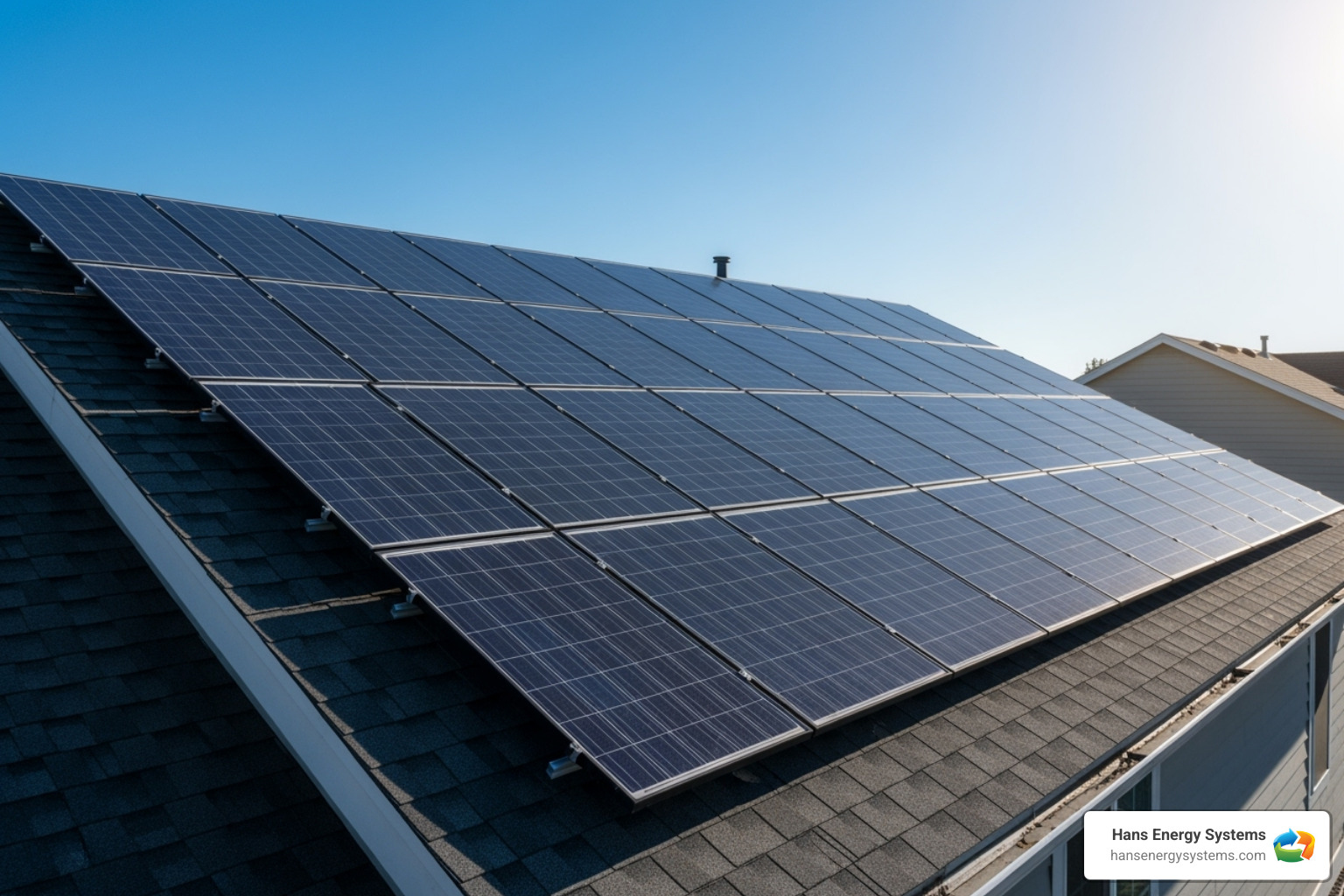
- Annual professional inspections catch issues like inverter problems or wiring wear early.
- Regular cleaning prevents efficiency loss (up to 30%) and the formation of damaging hot spots.
- Trimming nearby trees prevents shading and branch damage during storms.
- Installing pest guards prevents costly wiring damage from rodents and birds.
- Monitoring your system’s performance helps you catch sudden drops in production that signal a problem.
- Weather protection measures can prevent storm damage. Learn more about protecting solar panels from storm damage.
The small annual cost of maintenance protects your investment, extends your system’s lifespan, and ensures peak efficiency.
Frequently Asked Questions about Solar Panel Repair
Here are answers to three common questions we receive about solar panel repair.
Can broken solar panel glass be repaired?
Typically, no. While sealing a tiny chip with resin might be a temporary fix, it doesn’t solve the underlying problem. For large cracks or completely shattered glass, replacement is the only safe option.
The glass protects internal components from moisture, which can lead to corrosion, short circuits, and even fire hazards. Significant glass damage also severely reduces a panel’s efficiency and compromises its structural integrity.
How long do solar panels last before needing major repairs?
Solar panels are built to last 25 to 30 years, a lifespan supported by most manufacturer warranties. Because they have no moving parts, major repairs are uncommon with quality installation and basic maintenance.
Panels experience a normal, gradual degradation in output of about 0.5% to 1% per year. Most issues that arise are related to routine upkeep, like cleaning or tightening connections, not major failures. As research shows, [with proper care, solar panels can last 20-30 years](https://trellis.net/article/what-will-happen-solar-panels/) without significant intervention.
What is the most common cause of solar panel failure?
The answer depends on whether you mean the entire system or just the panels.
For the entire solar system, the inverter is the most common point of failure. It is the hardest-working component and is the most likely to need service or replacement over the system’s life.
For the panels themselves, the most common issues are:
- Microcracks: These tiny, often invisible fractures result from thermal stress or handling during installation. They can create hot spots and gradually reduce efficiency.
- Weather-related damage: Hail, strong winds, and falling branches can cause significant physical damage to panels.
- Natural wear and degradation: This is the slow, expected loss of efficiency that occurs over a panel’s multi-decade lifespan.
Most of these issues are either preventable with good maintenance or fixable with professional solar panel repair.
Conclusion: Protecting Your Solar Investment
Your solar panels are a long-term investment in your home and a cleaner future. Proper solar panel repair and maintenance are key to protecting that investment.
A solar system thrives with attention. Regular cleaning can prevent up to 30% energy loss, while simple visual inspections help you spot small issues before they become big headaches. Common problems like loose connections, accumulated debris, or minor wiring issues are manageable when caught early, acting as a tune-up for your system.
However, it’s crucial to know your limits. Solar panel repair involving electrical components, major damage, or complex diagnostics requires professional expertise. Choosing a professional protects your safety and your warranty—it’s the smartest choice.
Handle the simple maintenance you can safely manage, and trust the experts with the rest.
For residents in San Diego County seeking expert diagnostics and reliable service, Hans Energy Systems provides comprehensive solutions to keep your system running at peak performance. Our team understands that your solar investment deserves careful, professional attention when issues arise beyond basic maintenance.
Your solar panels are designed to perform for decades. With a balance of proactive maintenance, prompt attention to problems, and professional expertise when needed, your system will continue delivering clean energy and meaningful savings for years to come.
Ready to ensure your solar investment stays protected? [Schedule your professional solar panel repair service today](https://hansenergysystems.com/hvac/poway-ca/solar-panel-repair/) and let our experienced team help you maximize every ray of sunshine.


